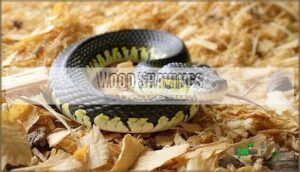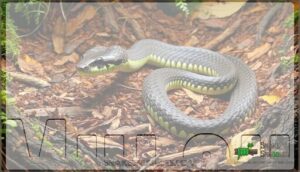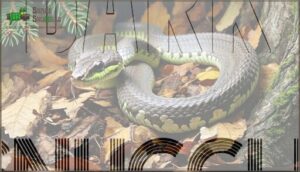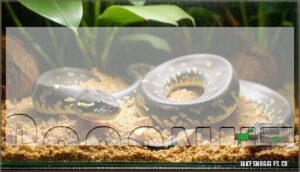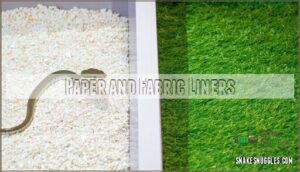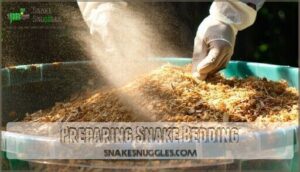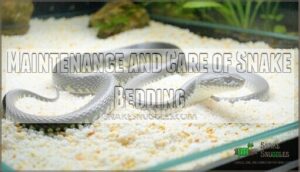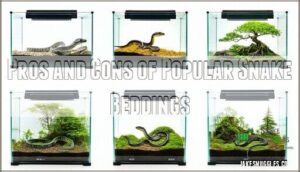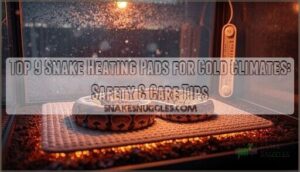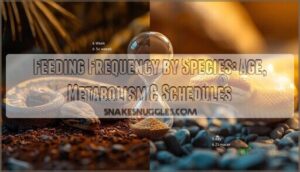This site is supported by our readers. We may earn a commission, at no cost to you, if you purchase through links.
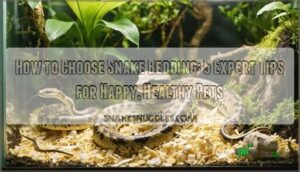 When you’re learning how to choose snake bedding, think of it like picking the perfect mattress – comfort matters!
When you’re learning how to choose snake bedding, think of it like picking the perfect mattress – comfort matters!
Start by considering your snake’s natural habitat. Ball pythons love humidity, so coconut husk or cypress mulch works great. Corn snakes prefer drier conditions, making aspen shavings ideal.
Safety comes first – avoid cedar or pine shavings, which can irritate your scaly friend’s respiratory system. Paper towels work fine for beginners, though they’re not exactly Instagram-worthy.
Check for dust-free options and verify easy cleaning. Your snake spends most of its time on this substrate, so don’t cut corners. The right choice affects everything from shedding to overall health.
Table Of Contents
- Key Takeaways
- Types of Snake Bedding
- How to Choose Snake Bedding
- Preparing Snake Bedding
- Maintenance and Care of Snake Bedding
- Pros and Cons of Popular Snake Beddings
- Frequently Asked Questions (FAQs)
- What kind of bedding is best for snakes?
- How often should you change snake bedding?
- What is the best flooring for snakes?
- What is the best substrate for snakes in humidity?
- How do you choose bedding for a snake?
- What kind of bedding should a snake eat?
- What is the best snake bedding?
- Why do different snake keepers choose different bedding?
- Can snake bedding be used for pets?
- Are snake beddings good for a tropical or arid snake?
- Conclusion
Key Takeaways
- Match your snake’s natural habitat needs – use cypress mulch or coconut fiber for humidity-loving species like ball pythons, and choose aspen shavings for dry-climate snakes like corn snakes
- Prioritize safety by avoiding cedar or pine shavings that can irritate your snake’s respiratory system, and select dust-free options to protect their health
- Prepare natural substrates properly by freezing them for 3-7 days to eliminate mites and parasites, or wash and bake materials at 200°F to remove bacteria and chemicals
- Maintain cleanliness with daily spot cleaning to remove waste immediately and complete bedding changes every 4-6 weeks to prevent odor buildup and bacterial growth
Types of Snake Bedding
You’ll find snake bedding options that range from basic newspaper to fancy coconut fiber, each with its own superpowers and quirks.
The trick is matching your snake’s natural habitat needs with what works for your cleaning schedule and budget.
Wood Shavings
Wood shavings, especially aspen, are a top choice for snake bedding thanks to their absorbency and burrowing benefits.
Looking for the perfect snake bedding? Aspen shavings deliver unbeatable absorbency and let your snake tunnel to their heart’s content.
However, shaving safety is key—avoid dusty brands to protect your snake’s health.
- Aspen pros: Great for burrowing and odor control.
- Avoid for high humidity concerns.
- Choose dust-free options.
- Monitor for mold in damp setups.
- Perfect for low-humidity snake care.
Mulch
Cypress mulch stands out as the humidity champion among snake bedding options.
This reptile substrate excels at maintaining moisture levels while providing excellent burrowing opportunities for your snake. However, watch for mulch impaction risks with smaller snakes who might accidentally ingest pieces.
Coconut fiber is another option, as it holds humidity well.
Here’s your mulch mastery checklist:
- Choose cypress mulch for superior humidity control and mulch aesthetics
- Monitor mulch safety by selecting appropriate-sized pieces for your snake
- Provide 2-3 inches depth to support natural mulch burrowing behaviors
- Replace monthly to maintain fresh reptile bedding conditions
Bark
Bark makes your snake feel right at home in nature’s embrace. Fir bark stands out as premium reptile substrate, offering excellent humidity levels control while providing burrowing benefits for ground-dwelling species. This reptile bedding creates a natural aesthetic that mimics forest floors perfectly.
However, mite control requires vigilance since bark can harbor unwanted guests.
Here’s what you need to know:
| Pros | Cons |
|---|---|
| Maintains ideal moisture | Potential mite issues |
| Natural forest appearance | Requires regular inspection |
| Great for burrowing snakes | Higher maintenance needs |
Coconut
For tropical species craving humidity, coconut fiber and coconut husk deliver perfect moisture control.
Coir advantages include excellent absorption and natural eco-friendliness.
Husk blends like ReptiChip offer burrowing opportunities while maintaining humidity control.
Coconut coir works wonderfully for ball pythons and green tree pythons.
Though pricier than newspaper, this substrate’s natural benefits make it worth every penny.
Paper and Fabric Liners
Think of paper bedding and fabric liners as your wallet’s best friend.
These terrarium liner options, including astroturf, offer excellent hygiene benefits and snake safety for non-burrowing species.
While paper liners lack visual appeal and enrichment options, their cost analysis shows they’re unbeatable for budget-conscious keepers.
Perfect for quarantine setups or when you need simple, effective substrate management.
How to Choose Snake Bedding
Now that you know your options, choosing the right snake bedding requires matching your pet’s needs with practical considerations. Your snake’s natural habitat drives everything else.
Consider Environment: Tropical species need humidity control through coconut husk or cypress mulch. Desert dwellers prefer drier options like aspen shavings for proper burrowing needs.
Evaluate Snake Safety: Skip cedar and pine – they’re toxic. Choose dust-free options to protect respiratory health.
Budget vs. Performance: Cost analysis matters, but don’t sacrifice odor control or your snake enclosure’s health for savings. One popular option is cypress tank mulch because it excels at moisture retention.
- Match substrate to your snake’s natural habitat requirements first
Preparing Snake Bedding
You can’t just dump fresh bedding into your snake’s home like tossing clothes in a hamper.
Proper preparation kills harmful bugs, removes dust, and guarantees your snake won’t get sick from contaminated substrate, which is a complete process to ensure the health of your pet.
Freezing Natural Substrates
Natural substrates can harbor unwanted guests like mites and parasites.
Even the cleanest-looking substrate can be crawling with invisible hitchhikers waiting to crash your snake’s party.
Mite elimination starts with proper freezing duration—freeze your substrate for 3-7 days at 0°F.
This snake bedding preparation works for most substrate types but raises safety concerns for bioactive substrate since it kills beneficial microorganisms.
| Substrate Type | Freezing Necessity |
|---|---|
| Coconut Husk | Mandatory – moisture breeds mites |
| Cypress Mulch | Essential – prevents pest introduction |
| Aspen Shavings | Recommended – guarantees nontoxic bedding |
Alternative methods include baking substrates.
Washing and Baking Bedding Materials
Washing and baking your snake’s bedding eliminates bacteria, parasites, and nasty chemicals like pesticides, herbicides, and chemical fertilizers that hitchhike on natural materials.
Here’s your game plan:
- Wash with mild soap, rinse until soap residue disappears completely
- Bake at 200°F for mite elimination without material degradation
- Cool completely before use to avoid safety concerns
- Monitor baking temperatures carefully to prevent scorching disasters
This simple process creates a cleaner, safer home for your slithery friend.
Proper cleaning may require specialized bedding washes.
Choosing Reputable Brands
Shopping for snake bedding feels like dating—you want someone reliable! Brand reputation matters because established companies like Zoo Med consistently deliver quality reptile substrates.
Check customer reviews before buying; they’re like friend recommendations for best snake bedding choices. Look for safety certifications that prove products won’t harm your snake.
Zoo Med products are readily available online. Product consistency means you’ll get the same quality every time. Ethical sourcing shows the company cares about environmental impact.
Trust proven brands—your snake’s health depends on it.
Maintenance and Care of Snake Bedding
You’ve chosen the perfect bedding for your snake, but now comes the real test—keeping it clean and fresh like a five-star snake hotel.
Think of bedding maintenance as your snake’s personal housekeeping service, where daily spot cleaning and weekly changes prevent your pet’s home from turning into a smelly mess that even a snake wouldn’t want to call home.
Weekly Changes
Between waste buildup and mite prevention, weekly changes keep your snake’s substrate fresh and healthy.
Frequency factors like enclosure size and humidity impact how often you’ll need deep cleaning.
Here’s your hygiene routine:
- Remove all old snake bedding completely to prevent bacteria growth
- Inspect for mold, mites, or unusual odors before adding fresh substrate
- Replace with clean material, ensuring proper depth for your snake’s comfort
Regular cleaning prevents most health issues.
Spot Cleaning
Beyond those weekly overhauls, daily spot cleaning keeps your snake’s home spotless.
Waste removal doesn’t require a hazmat suit—just grab tweezers or a small scoop.
Frequency matters more than you think.
Remove feces and urates immediately to prevent nasty smells from taking over.
Your hygiene practices directly impact odor control and preventing bacteria buildup.
To maintain a healthy environment, it’s essential to think about consistent environment maintenance.
Think of it like picking up after your dog, but smaller and less dramatic.
| Task | Tool | Frequency |
|---|---|---|
| Feces removal | Tweezers/scoop | Daily |
| Substrate spot check | Visual inspection | Daily |
| Urate cleanup | Paper towel | As needed |
| Bedding fluffing | Clean hands | Weekly |
Mixing Bedding Types Safely
Most snake keepers discover that mixing bedding types creates better environments than single substrates. You’ll want to combine materials thoughtfully to avoid digestive disasters.
Smart layering benefits include stable humidity gradients and enhanced burrowing blends for your snake’s comfort.
Here are four safe combinations to examine:
- Aspen shavings with coconut fiber – Perfect humidity balance for ball pythons
- Cypress mulch over paper towels – Easy cleaning with natural appeal
- Bark chips with coconut husk – Ideal for arboreal species needing climbing surfaces
- Fine substrates on bottom, larger pieces on top – Prevents accidental ingestion
Always test new substrate mixtures for mold growth before full implementation. Many keepers buy aspen bedding from online retailers.
Remember, digestion risks increase when particle sizes vary dramatically, so keep snake health as your top priority when experimenting.
Pros and Cons of Popular Snake Beddings
You’ll find that each popular bedding option comes with its own set of trade-offs, like choosing between a sports car and a pickup truck.
Understanding the specific strengths and weaknesses of newspaper, aspen shavings, cypress mulch, and coconut husk will help you make the best choice for your snake’s needs and your budget.
Newspaper
Newspaper is the budget-friendly champion of snake bedding options.
You can’t beat its cost effectiveness and hygiene benefits, making it perfect for quarantine use when monitoring new arrivals.
However, readability concerns arise with colored inks – stick to black and white to avoid ink toxicity issues.
This substrate works great for temporary setups, though it won’t win any beauty contests in your snake enclosure.
Aspen Shavings
Aspen shavings work well for snakes that love to burrow.
This popular snake bedding offers excellent odor control and stays relatively dust-free.
However, you’ll need to watch for mold prevention in humid snake enclosures.
Here’s what makes aspen shavings stand out:
- Burrowing Benefits: Perfect texture for digging species like corn snakes
- Odor Control: Naturally absorbs smells better than newspaper
- Dust Concerns: Minimal particles keep respiratory systems healthy
- Snake Size: Works best for smaller to medium-sized species
Cypress Mulch
Cypress mulch is a superstar for humidity control and moisture retention, making it perfect for species needing damp environments.
Its burrowing benefits and naturalistic look create a cozy retreat for your snake.
However, watch for mites—freezing or boiling the mulch helps.
As a top choice in reptile supplies, this snake bedding is safe, comfy, and ideal for maintaining a healthy habitat.
Some keepers prefer aspen, valuing its excellent absorbency for spills.
Coconut Husk
Looking for an eco-friendly substrate that won’t break the bank? Coconut husk delivers impressive moisture retention for tropical species while serving as an excellent burrowing medium.
This natural snake bedding option excels at humidity control, making it perfect for ball pythons and other moisture-loving snakes.
Here’s what makes coconut husk shine:
- Superior moisture retention without becoming soggy
- Less dusty than traditional coconut fiber options
- Natural mite prevention through proper preparation
- Cost-effective long-term bedding solution
- Eco-friendly sustainable substrate choice
Frequently Asked Questions (FAQs)
What kind of bedding is best for snakes?
You’ll want bedding that matches your snake’s natural habitat.
For humid-loving species like ball pythons, choose cypress mulch or coconut fiber.
Dry-climate snakes prefer aspen shavings.
Always avoid cedar or pine.
How often should you change snake bedding?
Most snake keepers change bedding every month unnecessarily. You’ll actually need spot-cleaning daily and full changes every 4-6 weeks, unless it’s looking like a disaster zone or smelling funky.
What is the best flooring for snakes?
Aspen shavings work best for most snakes since they’re safe, absorbent, and allow burrowing.
You’ll want cypress mulch for humidity-loving species like ball pythons, while paper towels suit quarantine situations perfectly.
What is the best substrate for snakes in humidity?
For high-humidity snakes, you’ll want cypress mulch or coconut fiber as your top picks.
These substrates hold moisture like champions while preventing mold.
Avoid aspen shavings—they’ll turn into a moldy mess faster than week-old leftovers.
How do you choose bedding for a snake?
Like selecting the perfect chariot for your scaly companion, you’ll consider your snake’s natural habitat first.
Match humidity needs—tropical species need moisture-retaining substrates like cypress mulch, while desert dwellers prefer dry aspen shavings to ensure their environment is suitable.
What kind of bedding should a snake eat?
Your snake shouldn’t eat any bedding at all.
If they’re munching on substrate, it’s dangerous and can cause serious blockages.
Switch to safer options like paper towels until you identify what’s triggering this behavior.
What is the best snake bedding?
Picture your corn snake happily tunneling through fresh aspen shavings like a scaly bulldozer.
You’ll want aspen for dry-climate species, cypress mulch for humidity-loving ball pythons, or coconut fiber for tropical snakes needing moisture.
Why do different snake keepers choose different bedding?
Different keepers choose different bedding because each snake species has unique needs.
Your ball python craves humidity while your corn snake prefers dryness.
Personal preferences, budget constraints, and cleaning habits also influence choices.
Can snake bedding be used for pets?
Snake bedding isn’t designed for other pets like cats, dogs, or hamsters.
You’ll want species-specific substrates since each animal has different safety requirements, humidity needs, and behaviors that affect their bedding choices, considering their unique needs is crucial for safety.
Are snake beddings good for a tropical or arid snake?
Wondering which bedding suits your snake’s climate?
Tropical snakes thrive with cypress mulch or coconut fiber for humidity control.
Arid species like corn snakes prefer aspen shavings that stay dry and prevent mold.
Conclusion
Choosing the right bedding is like laying the foundation for your snake’s happiness – get it wrong, and everything else crumbles.
Now you know how to choose snake bedding that keeps your pet healthy and comfortable.
Remember to match substrate to species, prioritize safety over aesthetics, and maintain proper cleaning schedules.
Your snake can’t tell you "thanks," but healthy sheds and active behavior will speak volumes. Happy snakes make happy owners!
- https://www.valspar.com/en/colors/browse-colors/lowes/yellow/coconut-husk-8003-20g
- https://www.chameleonforums.com/threads/question-about-reptile-carpet.44823/
- https://www.instagram.com/dr.lyle.dvm/
- https://www.seaislandanimalhospital.com/staff/dr-beth-bystrom
- https://www.kwikpets.com/blogs/reptiles/7-bedding-options-for-your-pet-snake

